THE CHAMPAGNE EXPERIENCE – THE REGION AND ITS PLEASURES
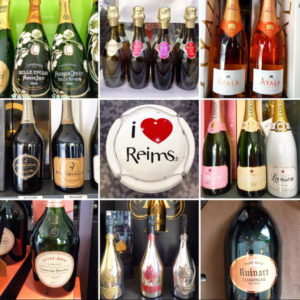
Say the word “Champagne”, and the first thing that springs to mind is the iconic sparkling white wine named for the region in N.E. France where it’s produced. It’s an area that’s close to Paris for a quick weekend visit, but it has so much more to offer! Champagne is world-renowned as a symbol of the French art of living, of festivities and celebration, literature, painting, music, cinema, photography and even comics, all testifying to the influence and constancy of this unique region’s image.
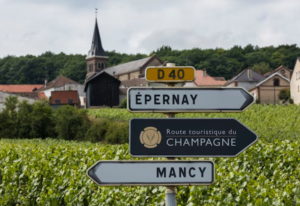
As I suggested in the last blog, a great introduction to the Champagne region is to start off in the beautiful medieval town of Troyes before turning northeast towards Reims. However, if time is short, the wine region is less than an hour by TGV train from Paris Gare de l’Est, or around 1 1/2hrs drive time.
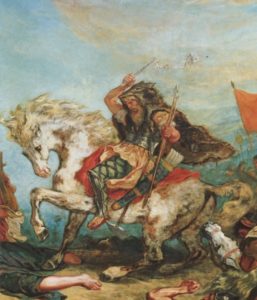
The location of the Champagne district played a large role in its history, given that it was at the crossroads for both military and trade routes. This meant that the area was subjected to devastation and destruction during various military conflicts that were waged here, going back as far as 451AD when Attila and his Huns were defeated by an alliance of Roman legions, Franks and Visigoths at Châlons. This defeat was a turning point in the Huns’ invasion of Europe.
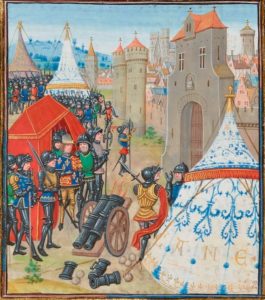
During the Hundred Years’ War, the region was repeatedly ravaged by battles and conflicts. A number of wineries and vineyards were destroyed in 1560 during the War of Religion between Huguenots and Catholics. This was followed by the Thirty Year War and the Fronde Civil War. It was not until the 1660s, during the reign of Louis XIV, that the region saw enough peace to allow wine production to resume, especially the advancement of sparkling wine.
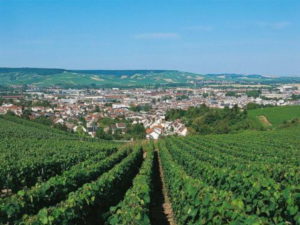
The region’s reputation for fine wine production dates back to the Middle Ages when Pope Urban II, a native Champenois, declared that the wines produced in the Aÿ department of the Marne were the best in the world—similar to the description of the wines of their rivals from Beaune in the Burgundy district. As the region’s reputation grew, popes and royalty sought to own land in the area. Pope Leo X, Francois 1er of France, Charles V of Spain and Henry VIII of England all owned vineyards in the region at some stage. In 1518 a shipment of wine from Aÿ sent to Henry VIII’s chancellor, Cardinal Wolsey, is the first recorded export from the Champagne region to England.
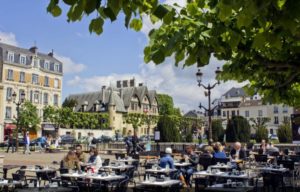
The most convenient town to use as a base is Reims. It’s a lively university city, there’s a good choice of accommodation and restaurants as well as a having good rail links. If you’re not driving there’s also a rail link on the TER regional trains between Reims and Epernay that the locals tend to refer to as the “Ligne de Bulles”(the Bubbles Line), which is self-explanatory!
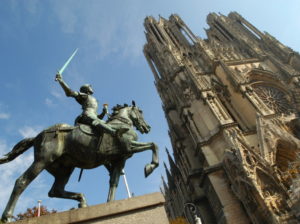
The city of Reims has played a vital role in the history of France. Founded by the Gauls, Reims became a major city during the Roman era. The prosperity of the area around Reims increased when the Emperor Charlemagne encouraged the area to start planting vines and was further enhanced with the coronation of his son, Louis the Pious. Reims continued to play a prominent ceremonial role in French monarchical history as the traditional site of the coronation of the kings of France. 33 Kings were crowned in Reims Cathedral from 816 to 1825, one of the most memorable being Charles VII in 1429, who was accompanied by Jeanne d’Arc.
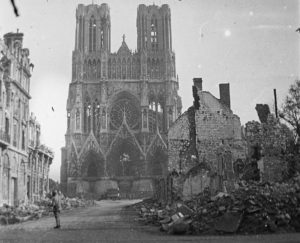
Badly damaged during WW1 by the Imperial German Army in an attempt to shake French morale, the Cathedral needed a great deal of rebuilding, and many of the sculptures on its façade are copies or casts. The American John D. Rockefeller, together with the Danish Government, was the main donor for the difficult 10 year restoration and rebuilding program. It says much about the integrity of the work carried out that the Cathedral is still considered one of the finest examples of Gothic architecture in the world.
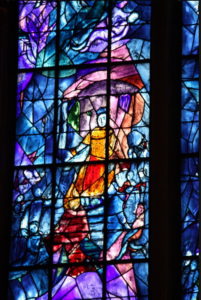
The interior is equally impressive, where the stained-glass windows from the 13th century vie for attention alongside the 9 magnificent stained-glass windows designed by Marc Chagall commissioned by the Cathedral and completed in 1974. Chagall seemed to have a natural affinity for the medium of stained glass, carrying out important commissions in numerous cities, saying that “For me, a glass is a transparent wall located between my heart and the heart of the world. Stained glass has to be serious and passionate. It is something elevating and exhilarating.” The Cathedral’s main western façade is beautiful and changes its character during the day. During the summer months, the Cathedral is lit up at night in a spectacular Son et Lumiere show.

The former archbishop’s palace, the Palais du Tau, is next door to the Cathedral. It’s now a museum holding artifacts and exhibits relating to the Cathedral, especially its architecture, development and repair over the centuries, as well as artifacts such as robes relating to the coronations of French kings from 1223 to 1825.
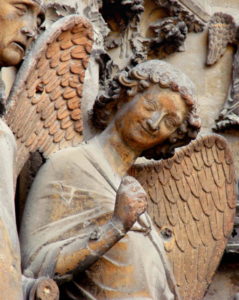
Some of the Cathedral’s earliest and most notable statues and carvings are here, having been removed for preservation and replaced with copies. You can see the original L’Ange au Sourire (smiling angel) here, replaced on the Cathedral by a wonderful reproduction. The original angel that was once on top of the spire is also here. The Palais du Tau is also where you buy tickets for the walking tour of the Cathedral towers. These tours take around an hour and limited to 16 people. You can save a few Euros if you get a combined ticket for both the towers and the museum.
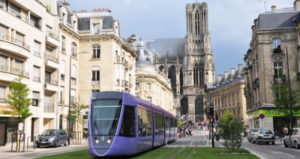
The centre of Reims and its top sights are easily walkable, though you may want to use a tram or city bus to reach some of the farther wineries or museums. Head to the main Tourist Office, located just off the parvis (forecourt) of the Cathedral, for maps etc. There’s also a smaller office just outside the main entrance of the railway station.
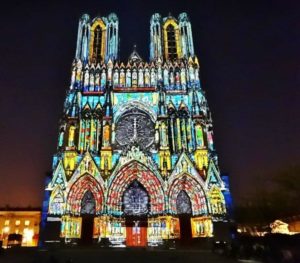
The city was designated a City of Art and History in 1987, in recognition of the diversity of its heritage, ranging from Romanesque to Art Deco. Since 1991, Reims Cathedral and Palais du Tau Palace (the former archbishop’s palace) were inscribed on the UNESCO World Heritage List. In 2015, the historic hillsides, Champagne Houses and cellars were also listed as a World Heritage Property due to their very specific agricultural and production landscape that bear clear testimony to the development of a very specialised artisan and agricultural enterprise.
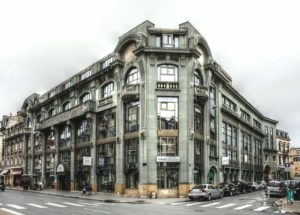
When we think of the architectural treasures of Reims, we tend to think of the Cathedral and other similarly venerable buildings, so it can come as something of a surprise to discover that Reims is considered to be the Art Deco capital of France. Due to the heavy damage sustained in WWI, the town commissioned more than 100 architects for the reconstruction work. They mostly rebuilt the city in the Art Deco style, so that the city was regarded as something of a creative laboratory for architects. Especially beautiful houses from this period are located on Bvd Foch and Cours Jean-Baptiste Langlet.
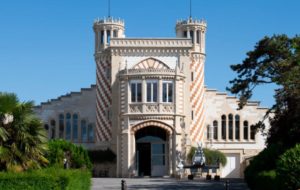
Diagonally opposite Champagne Vranken Pommery, one of the unexpected gems of Reims is the incredible Villa Demoiselle, located at 56 Bvd Henry Vasnier.
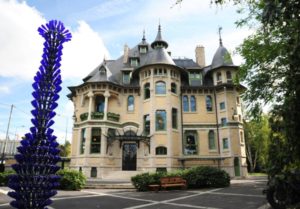
Built between 1904 and 1908, this former mansion is a blend of Art Nouveau and early Art Deco. Acquired in 2004 by Paul-Francois Vranken, the villa and gardens were in a sad, dilapidated state.
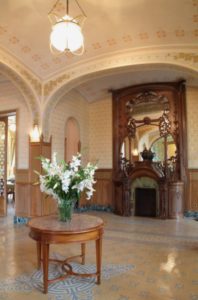
No expense was spared in the restoration of the house and the gardens to return them to their former splendour. The house has the most exquisite Art Nouveau interiors and furnishings with sculpted fireplaces, carved timberwork and stained glass windows and fine paintings. Open all year round, but opening days and times vary, so check first with the Tourist Bureau beforehand. The Villa is included in the World Heritage List for the district.
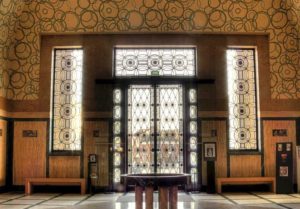
Another highlight of Reims is the Bibliothèque Carnegie, named after the prominent American industrialist and philanthropist, Andrew Carnegie, who funded the construction of the city’s library after WW1. Combining the mission of heritage conservation and of a public library, from the outside it resembles a Greek temple, inside, the beautiful mosaics, the chandelier in the entrance hall and the huge glass roof by Jacques Gruber, are Art Deco masterpieces.
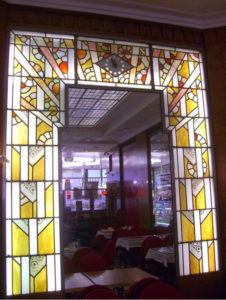
After the visual feast of these magnificent buildings, the perfect way to finish off your walking tour is to adjourn to the Art Deco splendour of Patisserie Waïda and enjoy a delicious pastry or two in the Salon de Thé.
Many of the Champagne houses in Reims, Épernay and the surrounding area offer guided visits of their caves and facilities. Generally, you pay a fee which includes a tasting at the end of the tour. The larger houses offer tours in French, English and other languages, but smaller houses may only have French language tours, so do check ahead with the Tourist Bureau. Note that most of the Champagne houses only take pre-bookings for tours. As a number of the houses are obviously out in the countryside, unless you’re driving, consider booking a tour that includes transport back and forth.

The exceptional Ruinart Champagne house is one to put on your list to visit. The oldest in the district, the house was first established in 1729 by Nicolas Ruinart, who named it after his uncle Dom Ruinart, a modest and hardworking monk who shared his passion for sparkling wine. It’s now one of the biggest and most prestigious names in Champagne and is known for its vast underground chalk tunnels, where the wine slowly matures. A tour takes you to a depth of 38m. below ground the see workings of the house. You can book a celebratory lunch or special dinner in the historic house. Ruinart has been a designated historic site since 1931. It’s a 20 min. drive S.E. of Reims. Other famous Champagne houses, such as Taittinger, G.H. Martel and Vranken Pommery are in Reims.
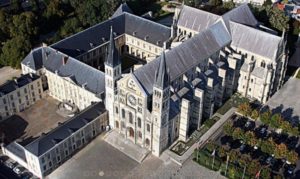
A spectacular site not to be missed is the Basilique Saint-Remi de Reims, built in the year 1000 AD and extended in the 12th century, which included the superb stained glass windows. Listed as a UNESCO World Heritage Site, this beautiful, serene church is a harmonious blend of history and art which should not be missed.
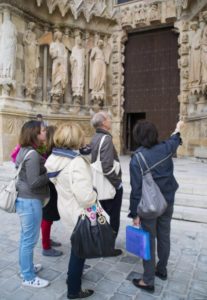
A great way to get a good understanding of Champagne and the district is with a group of local volunteers, known as Greeters. These dedicated locals share their passion for and knowledge of Champagne, guiding you around the city free of charge, sharing with you their anecdotes and showing you their favourite places. Ask the Tourist Bureau for details.
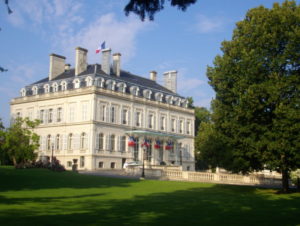
Épernay lies about 30kms to the south of Reims, and the easiest way to get there from Reims if you’re not driving is by the local train as mentioned above.
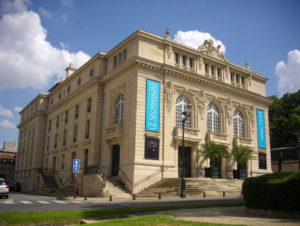
Set against a backdrop of vineyards extending into the distance, this picture-postcard town offers lots to see, so be sure to stroll through the beautiful park of the Hôtel de Ville—the former Hôtel Particulier (mansion) of Victor Auban-Moët built in 1858—the Gabrielle Dorziat Theatre, the Synagogue and the Maison de Louis Savoie, built in Renaissance style.
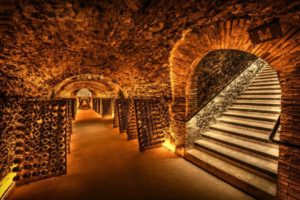
Beneath the streets of Épernay in 110km of subterranean cellars, where more than 200 million bottles of champagne are resting, just waiting to be popped open for a celebration or festive occasion. The town is the self-proclaimed capital of Champagne, having a veritable who’s who of the most celebrated champagne houses, which line the Avenue de Champagne. A good place to start first up is the Tourist Office at no. 7 Avenue de Champagne for maps and useful info. about nearby towns in the district.
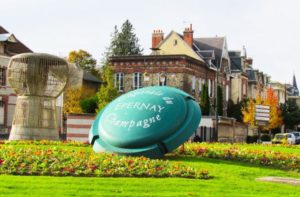
Whether you’re in town to sample fine champagnes or not, the pedestrian-friendly Avenue de Champagne is the place to start exploring, since this is where the town’s most magnificent architecture is found, in the form of stately 19th century mansions built for Champagne houses such as Moët & Chandon, Perrier-Jouët, Pol Roger and Mercier just to name a few.
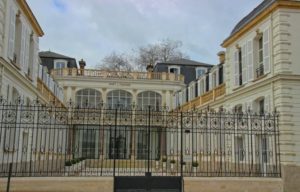
The Avenue de Champagne has the longest maze of underground tunnels in the district extending to around 30kms. Several of the Champagne houses along the Avenue offer tours and tasting opportunities, and one of the most highly regarded is Moet & Chandon.
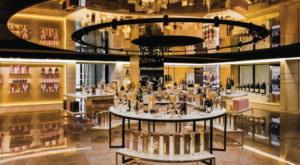
In the entrance to their building is a statue of Dom Perignon, the monk who is credited with inventing champagne (although this story is disputed by some researchers) and who worked at an Abbey not far from these offices. Since the house is owned by LVMH, it should come as no surprise that the Moët & Chandon shop is spectacular!
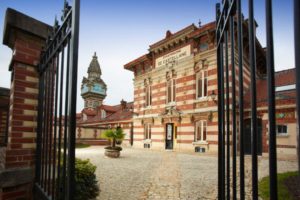
There are also smaller, lesser-known Champagne houses along the Avenue de Champagne, notably De Castellane, at no. 63 in a beautiful Art Nouveau house built in 1895 with a large tower that can be seen from all over Épernay. The interior of the house is a superb Art Nouveau gem, and there’s also a large art collection that visitors can enjoy.
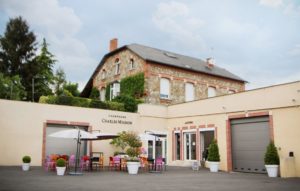
Another interesting possibility in Epernay is the highly regarded Champagne Charles Mignon at 6 rue Irène Joliot Curie, an easy 10 min. walk from the railway station. This family enterprise offers more of a one-on-one tasting experience rather than a large group tour in one of the large houses. Small group tours by by appointment only.
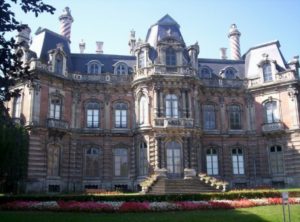
Further along Avenue de Champagne is Château Perrier, built by Pierre-Nicholas and Adele Perrier in 1854, in the Louis XIII style and stands as a magnificent example of Late Romantic French architecture. It originally served as their private home. In WWII the château served as Army headquarters, first for the British Army in 1940, then for the Germans (1942-44), then for the Americans under General Patton in 1945. After the war it was converted into the Épernay Municipal Library and Museum, and since 1950 it has housed the regional museum of prehistory and archaeology, with an important collection comprising some 80,000 regional artifacts dating from the Paleolithic to the Early Middle Period, along with 4,000 artifacts and documents relating to the history of Champagne winemaking.
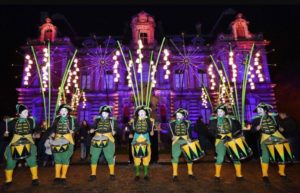
Épernay plays host each June to August to the Festival Summer Music, and even a mid winter visit has its highlights. For 3 nights in mid-December the town dons its finery with a spectacular light show called “Les Habits de Lumières”, where the Avenue de Champagne and its numerous houses are illuminated.
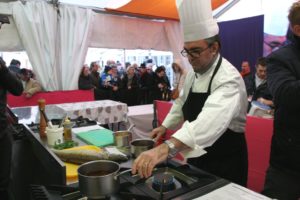
There are also street performances, music, fireworks, and champagne bars are set up, along with “Les Habits de Saveurs”—food and wine pairing workshops, cooking demonstrations by top chefs, and special cellar visits, which is a great opportunity to taste vintages produced by small producers as well as major brands. On the Sunday morning there is a concours (parade) of several hundred collectors’ cars, and in the afternoon there’s a tea party especially for children.
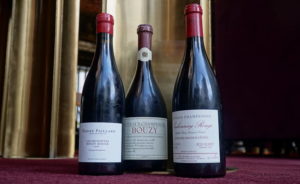
While totally dominating the region’s production, sparkling Champagne is not the only product that is made from the region’s grapes. Still wines, such as those made round the village of Bouzy, are sold under the appellation Coteaux Champenois. There is also a rosé appellation in the region, Rosé des Riceys, and a vin de liqueur called Ratafia de Champagne.
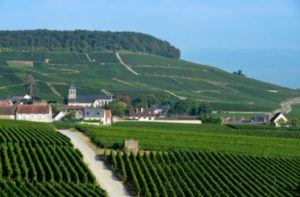
However, since the profits from making Champagne from the region’s grapes is much higher, production of these non-sparkling wines and fortified wines is quite small. The pomace, or solid waste from the grapes, is used to make Marc de Champagne (“Grappa” to the Italians).

The Champagne region has so much to offer, it’s a pity that many visitors to the area only visit Reims and or Epernay. Aside from visiting the Champagne houses, there’s plenty of interesting sights to explore and enjoy. One great way to experience a different perspective of the Champagne district is to take a hot air balloon over the Route du Champagne and the Regional Mountain Park of Reims and vineyards, with Champagne on landing. Or go up, up and away in a tethered balloon, summer months only, for a 360 deg. view of Epernay from 150m up in the air. Sipping Champagne from that height is sure taste rather special! Check out companies such as France Montgolfières and Ceetiz.
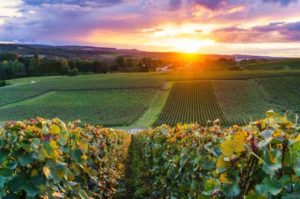
There are many different landscapes in Champagne. It’s an area with thick forests, sunlit fields, vast lakes and numerous pretty towns and villages, including gems such as Langres, Aÿ, and Hautevillers, amidst lovely, rolling countryside—and it goes without saying, great regional food! I’ll take a look at some of these enticing options in the next Blog post.
A love of Champagne helped save France in World War II:
“Remember!” said Winston Churchill, “It’s not just France we are fighting for, it’s Champagne!”


Bonjour Cheryl
Your article on Champagne brought back all the memories I have of a very special visit to the Caves of Maison Ruinart in November 2014. As you suggested I took the TGV from Paris to Reims , a taxi to the Chateau and then the amazing hour long tour of the caves, then an hour in le salon with the tour leader (only five people in the tour) and at 11 am here we were dinking blanc de blanc and rosé our choice either vintage or non vintage! Next visit to France will be a two day visit to the amazing area and experience the fascinating way they produce this very special product. Thank you for the reminder!
Salut. Pam
Bomjour Pam!
Like you, we did a tour of one of the great Champagne houses–in our case, it was Veuve Clicquot–many years ago. We’d gone out to Reims and Epernay with two Sydney friends who were then living in Paris for a few years. It was mid January, if I recall, and bitterly cold. However, the finale of the very interesting tour (again, like yours, it was a very small group), we managed to warm ourselves extremely well at the very generous tasting session. Many bottles were opened, to give each of us a try at doing it properly! As you say, it’s a very interesting area to explore, with so much more to offer than “just” Champagne–although some would argue that that is hardly a problem!
Cheers, Cheryl